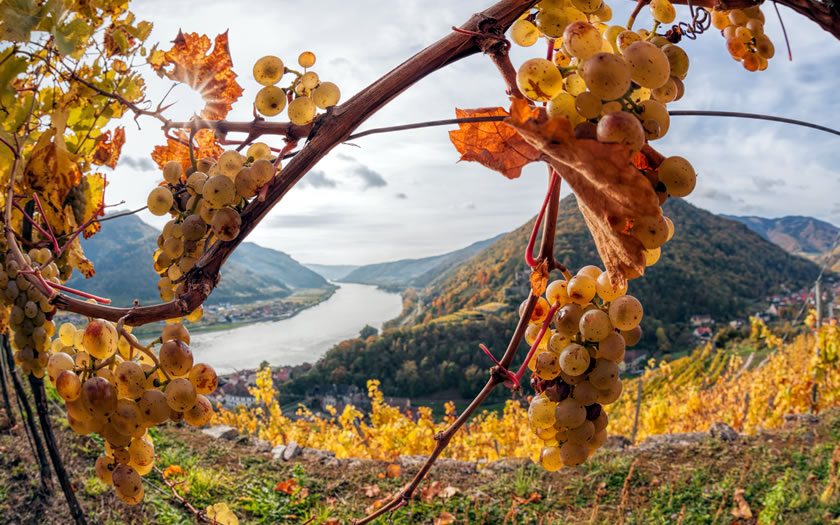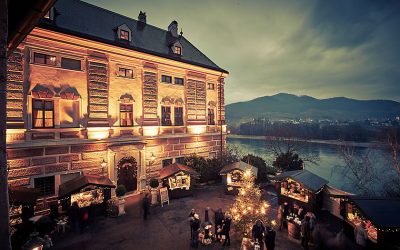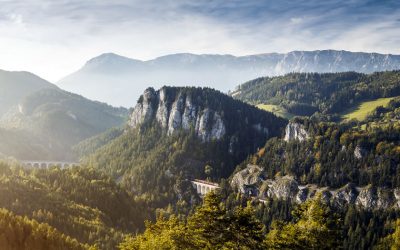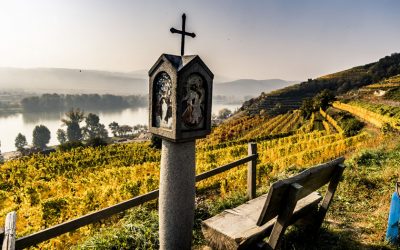Last updated on May 1st, 2022 at 11:57 am
Lower Austria’s Wachau valley region is one of the most popular tourist destinations in the country. Not only that, but it has also been declared a location worthy of inclusion on the UNESCO World Heritage site list as part of the cultural landscape of Austria.
Where is the Wachau valley in Austria?
The Wachau valley is a stretch of the river Danube, roughly between the towns of Krems and Melk in Lower Austria. It is located around 100 kilometres to the east of Linz and around 80 kilometres to the west of Vienna. St Pölten, the provincial capital of Lower Austria, is less than 30 kilometres away to the south and east.
Map of the Wachau valley region
Here is a map showing the Danube river and the main towns along the Wachau valley:
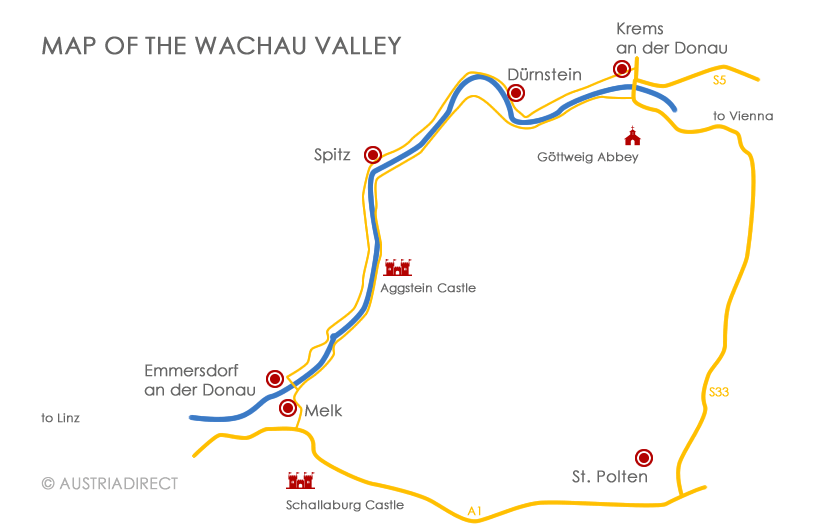
Why visit the Wachau region?
The images of the Wachau are famous around the world, with the Danube river and its cruise ships winding through the vineyards and the hills on either bank. Perched high above at strategic points are the famous Wachau castles from the Middle Ages, like the Dürnstein ruins and Schloss Aggstein, not forgetting two of the most historic abbeys in Austria at Melk and Göttweig.
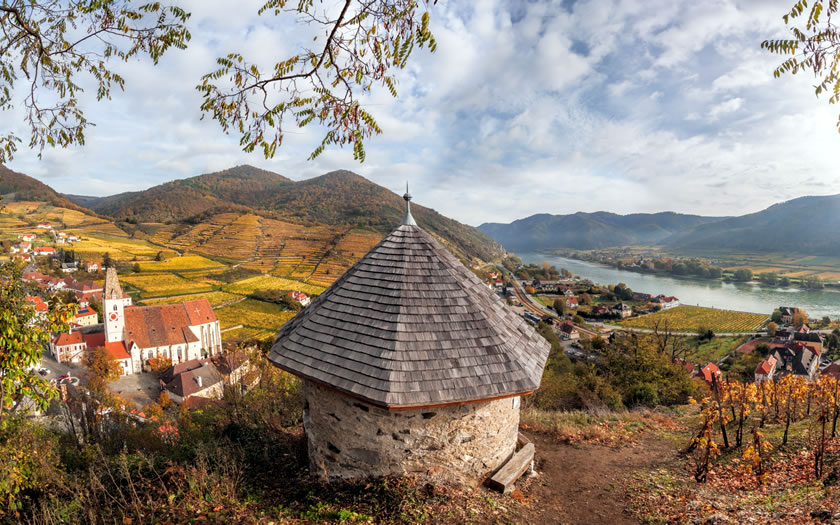
And, of course, the Wachau valley is easily accessible from Austria’s capital city and number one hub for visitors…
How to get to the Wachau valley from Vienna
Many of the visitors to the Wachau from Vienna are just coming for a day trip to see the main sights. There are a number of transport options for them:
Driving to the Wachau region from Vienna
The easiest way to get to the Wachau from Vienna by car is to take the S5 Schnellstrasse to Krems an der Donau. (This is an express route which is classed the same as a motorway so requires a motorway vignette.) From here the B3 (the Donau Bundesstrasse) runs along the north bank of the Danube to the town of Emmersdorf an der Donau opposite Melk. An alternative or possible return route is the B33 which covers the southern bank of the Danube.
Wachau Railway
Those relying on public transport might like to use the train to explore the Wachau.
The Wachaubahn (‘Wachau railway’) runs four times a day in summer and can be reached from Vienna on connecting services to Krems from Franz-Josefs-Bahnhof just to the north of Vienna city centre.
The rail service takes just under an hour to travel from Krems through to Emmersdorf an der Donau. From there bus connections to Melk and to Schallaberg castle are also available.
Wachau valley tour on the river Danube
An alternative independent day trip is to explore the Wachau by taking an early train from Vienna Meidling station to Melk and then hop on a Danube river cruise going downstream to Spitz or all the way through to Krems.
It is also possible to take a Wachau valley day trip on a boat from Vienna including breakfast, lunch, evening meal and afternoon snack, as well as an afternoon stop in Dürnstein.
What to see in the Wachau valley
In the Middle Ages, the Danube valley was an important trade route and castles were built at strategic points to protect the traffic (and to collect local tolls from the merchants passing through).
Castles in the Wachau
Dürnstein castle
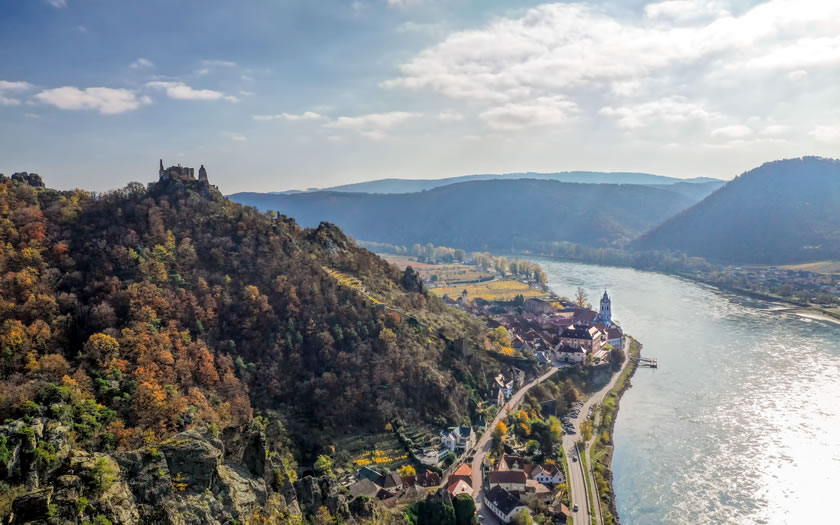
The ruins above the village of Dürnstein at the eastern end of the Wachau date back to the 12th century. Visitors from the UK may remember the tale of King Richard I (‘Richard the Lionheart’), who was held prisoner here during his return from the Crusades. The castle was destroyed during fighting in the Thirty Years War and has remained as ruins over the centuries.
There is a marked walk to the ruins from the centre of the town which climbs around 150 metres in height.
Hinterhaus castle
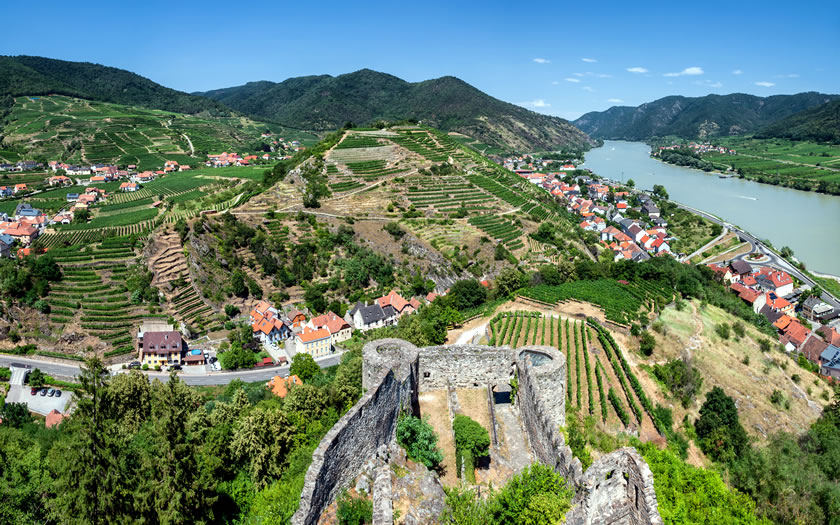
The Hinterhaus castle ruins are a little bit further upstream and located above the village of Spitz on the northern bank of the Danube. They also date from the 12th century, although the first mention of the building is to be found in the 13th century. The building was last fortified in the 17th century and since that time the many owners let it fall into ruin.
The still-impressive castle buildings can be visited by means of a marked walking trail, although the local tourist association warns against straying from the marked path and climbing any of the structure.
Aggstein castle
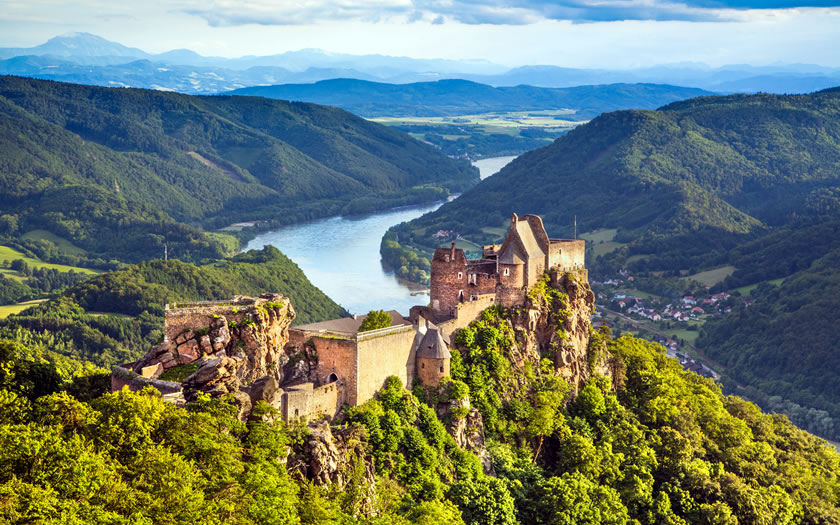
Aggstein castle is another ruined fortress dating from the early Middle Ages in a spectacular position on a rocky promontory above the Danube. The castle is located just outside the small settlement of the same name on the southern bank of the river. Unlike the other ruins, this castle underwent substantial preservation work in the 20th century and there is an entrance fee for the buildings. Visitors can either walk up from the Danube or drive up to the car park outside the castle. Tours of the castle are available in English and German.
Schallaburg castle
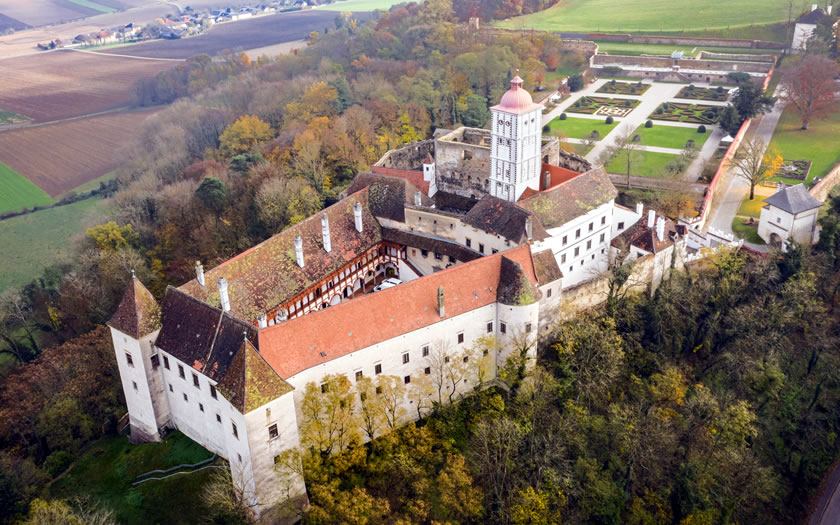
In contrast to the other castles listed here, Schallaburg castle is not a ruin and is not on the banks of the Danube. It is also from a different era than the others, being a renowned example of a Renaissance-style castle. The original buildings are thought to date from the 13th century but the castle was remodelled into its present form in the 17th century.
The property was in private hands until the post-Second World War period, when it became property of the Austrian government. It is now run by the state government of Lower Austria and offers guided tours and regular exhibitions. It can be reached by public transport from the town of Melk, five kilometres to the north.
Abbeys in the Wachau
Melk Abbey
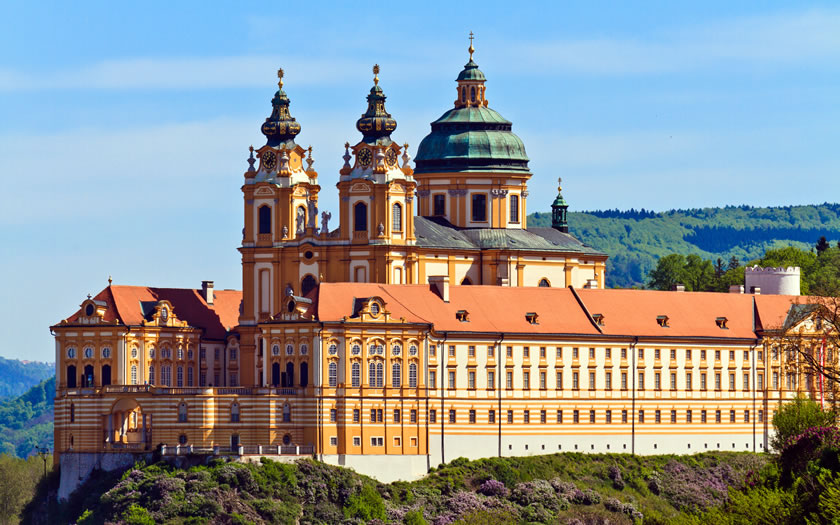
Melk Abbey towers over the town and the nearby river Danube from its imposing location nearly 60 metres above the water. The massive religious institution is one of the most famous in Europe and the Benedictine abbey is considered a masterpiece of Baroque architecture.
The monks still run a school here and the buildings house a number of exhibitions, as well as the abbey gardens. The abbey church is known for its decoration from the High Baroque era, with frescoes and the church altar being particular highlights.
Göttweig Abbey
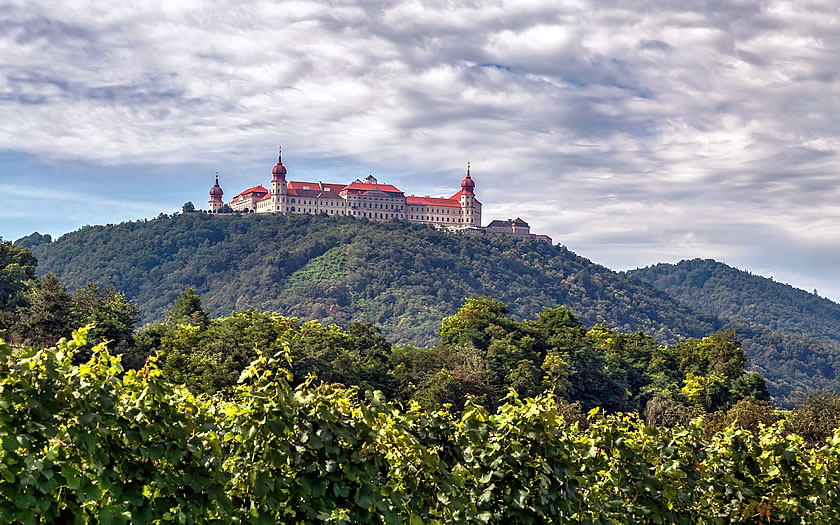
Göttweig Abbey is a short distance to the south of the Danube river and north of St. Pölten, in a commanding position above the surrounding vineyards. The tourist office publicity refers to it as ‘the Monte Cassino of Austria’ and it is easily seen from the Danube river cruiseships a few kilometres to the north.
The Benedictine abbey dates back to the 11th century but most of what can be seen these days is from the Baroque period of architecture. The interior of the abbey and the church above can be visited on a tour, while the restaurant at the base offers lovely views out over the Wachau region.
Towns in the Wachau valley
Plenty of visitors to the Wachau want to spend a little bit longer in the region, whether by travelling slowly through the villages and towns on foot or bicycle or taking the time to explore some of the smaller settlements and maybe taking in a wine-tasting or two.
Where to stay in the Wachau
Choose duration of stay in the search box below to discover accommodation availability in the Wachau region from our accommodation fulfilment providers Booking.com:
Booking.com
For those planning on spending a few days in this area, here are a few locations to consider when looking at where to stay in the Wachau valley:
Melk
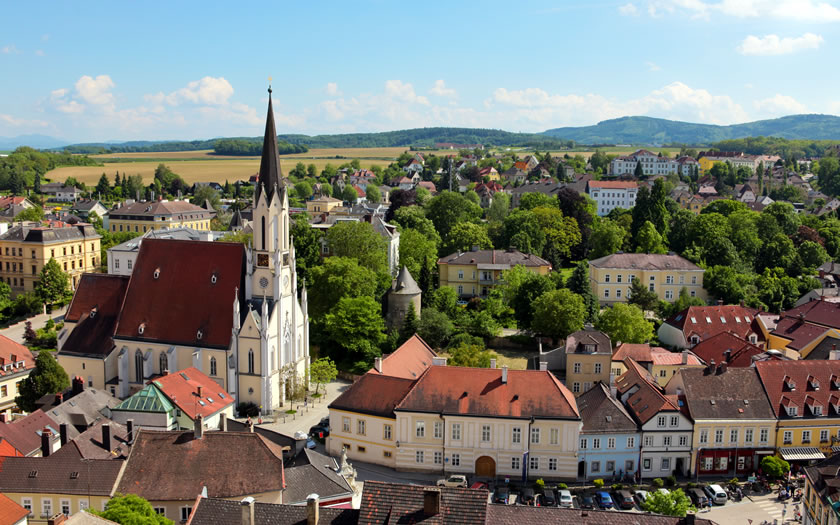
Melk is located on the southern side of the Danube opposite the town of Emmersdorf an der Donau. It makes a good base at the western end of the Wachau valley with easy access to the A1 motorway between Linz and St. Pölten.
Melk Abbey is obviously one of the main sights in the town, but visitors can also reach Schallaburg castle by bus from Melk. The town also has its own railway station, which has good connections via St. Pölten to Vienna.
Check accommodation availability in Melk
Spitz
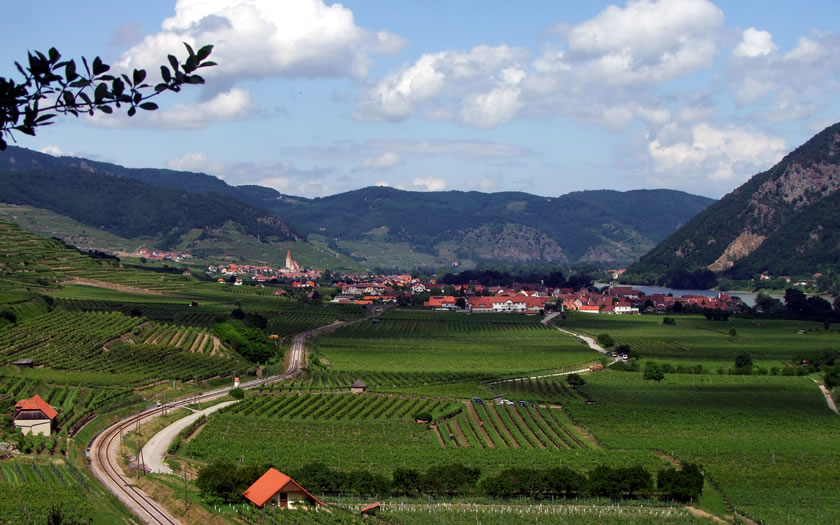
Spitz is a good place to take a longer look at the Austrian wine produced in the Wachau. The village, with the ruins of Hinterhaus castle overlooking it, is surrounded by vineyards mostly growing the Grüner Veltliner and Riesling grapes which are typical for the Wachau wine production. Vintners here produce around 60,000 litres of wine, mostly white, in a good year. The local wine can be tasted in the guesthouses and local restaurants, many of which are connected to a local vineyard.
Spitz also has a Renaissance era castle in the village centre (now used by the regional tourist board) and a maritime museum. It is a stop on the Wachaubahn local railway.
Check accommodation availability in Spitz
Dürnstein
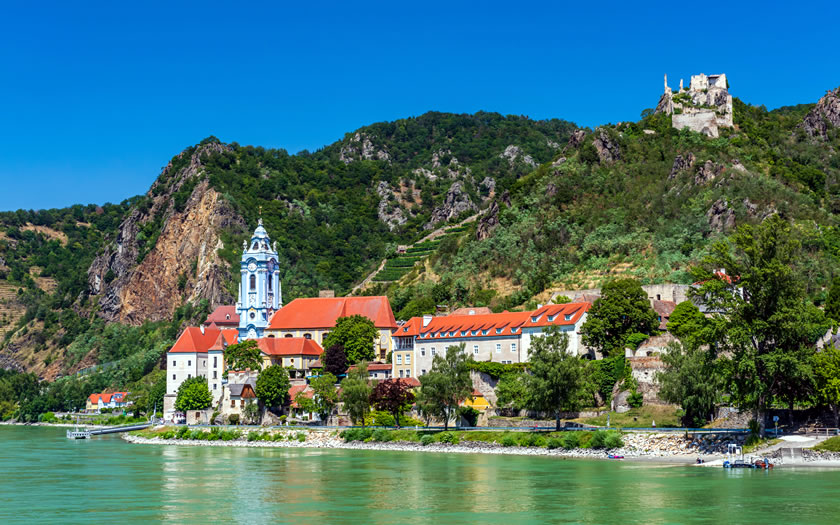
The town of Dürnstein is one of the major sights on any Wachau visit. The castle ruins sit high above the town and the blue and white steeple of the former Dürnstein Abbey. The abbey was remodelled in the Baroque style in the early 18th century before the religious institution was dissolved later on that century in the religious reforms of the Habsburg emperor. The former abbey church is also the parish church of Dürnstein.
Check accommodation availability in Dürnstein
Krems an der Donau
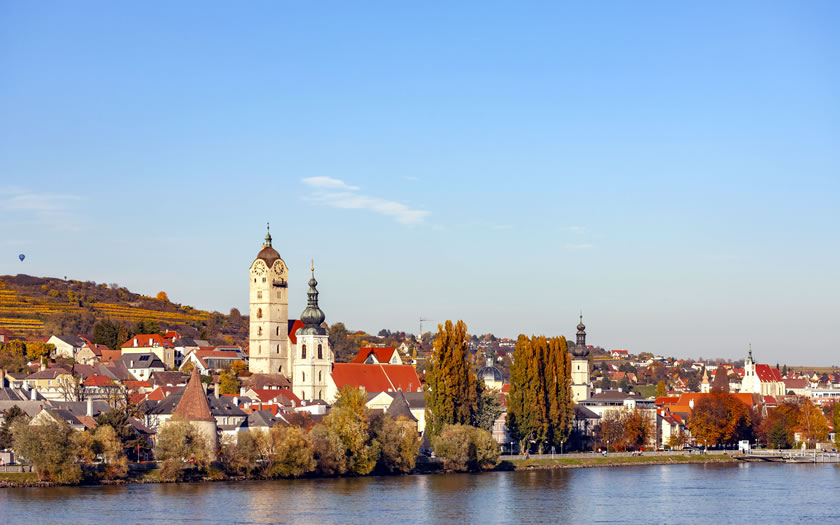
Krems is an important regional centre and transport hub for the Danube communities. Although it is much larger than other settlements in the Wachau with around 25,000 inhabitants, it still makes a good centre to explore the region and some of the other sights in this part of Lower Austria.
It is not without places of interest itself. The sights in the old town include the Steiner Tor, a medieval gate in what used to be the town walls, and a number of other historic buildings and churches.

